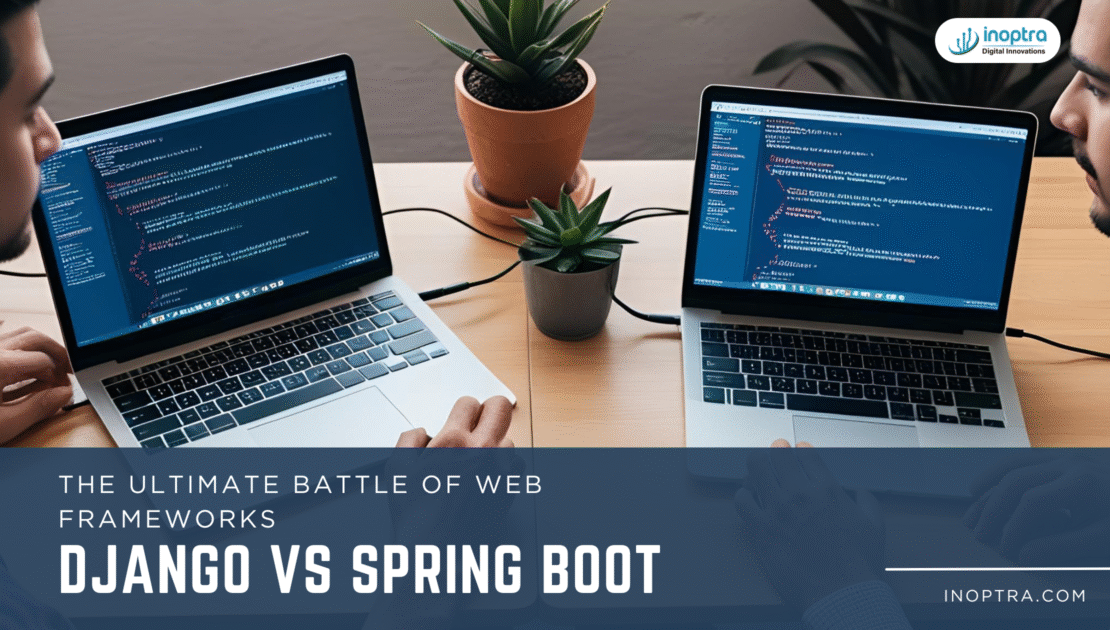
- May 29, 2025
- InOpTra
- Digital Applications
- No Comments
What’s In the blog:
- Development Speed & Productivity
- Simplicity & Code Conciseness
- ORM & Database Handling
- API Development with Django Rest Framework (DRF)
- Machine Learning & Data Analysis Potential
- Community & Hiring
- Infrastructure & Deployment
- Few Words Before Wrapping Up
Did you know that your choice of web framework can impact development time by up to 40%?
Welcome to the ultimate showdown between two titans of web development: Django vs. Spring Boot. These powerful frameworks dominate the backend landscape, yet they approach development from distinctly different philosophies. Today, we’ll explore their key differences and help you determine which might be the better fit for your next project. First-time developers and seasoned architects alike will find valuable insights in this comparison of these robust frameworks.
Development Speed & Productivity
Django shines when it comes to rapid development cycles. It provides an impressive array of built-in features including authentication, ORM, admin panel, and caching systems. These ready-to-use components significantly reduce development time and allow teams to focus on business logic rather than repetitive coding tasks. Furthermore, Django’s “batteries-included” approach means you’ll spend less time searching for compatible packages.
In contrast, Spring Boot often requires more manual configuration. Setting up security protocols, ORM systems, and managing dependencies can increase development overhead. However, this configuration flexibility becomes an advantage for highly customized applications. Nevertheless, when timeline efficiency matters, Django typically helps teams deliver functional applications faster with fewer resources.
Simplicity & Code Conciseness
In the context of discussing Django vs Spring Boot, let us highlight the simplicity and Code conciseness. Python powers Django’s elegant and readable syntax. The framework emphasizes less boilerplate code, making it exceptionally beginner-friendly. Python’s simplicity allows developers to express complex logic in fewer lines, resulting in more maintainable codebases. Additionally, Django’s straightforward structure makes it easier for new team members to understand project architecture quickly.
Spring Boot, built on Java, tends toward verbosity. It often requires configuring more code to achieve the same functionality as Django. While Java’s strict typing provides great stability, it comes at the cost of increased code complexity. Small teams usually find themselves more productive with Django’s concise approach, especially during early development phases.

ORM & Database Handling
Django’s ORM is unparallel for its simplicity and intuitive design. It effectively reduces SQL complexity while supporting PostgreSQL and other databases efficiently. Model definitions are clean and straightforward, allowing developers to focus on data relationships rather than query syntax. Moreover, Django’s migrations system handles database evolution smoothly.
Spring Boot relies on JPA/Hibernate for database interactions. This powerful but complex system requires careful handling of lazy loading, transactions, and numerous annotations. While it provides smooth control over operations in the database, the learning curve is higher. Django’s ORM generally makes inventory and data management easier with significantly fewer configurations.
API Development with Django Rest Framework (DRF)
Creating RESTful APIs becomes remarkably straightforward with Django REST Framework. DRF offers serialization, authentication, and browsable APIs right out of the box. The framework’s class-based views and viewsets dramatically reduce repetitive code. Furthermore, DRF’s documentation tools make API endpoints self-explanatory for frontend developers.
Spring Boot’s approach to REST APIs involves explicit configuration for controllers, serialization processes, and exception handling. This powerful approach requires more boilerplate code. Consequently, teams building API-centric applications often find faster development cycles with Django’s REST Framework.
Machine Learning & Data Analysis Potential
When we discuss about Django vs Spring Boot, python’s dominance in data science creates unique advantages for Django projects. The framework seamlessly integrates with NumPy, Pandas, and various AI/ML frameworks. This integration becomes invaluable when projects evolve to include analytics or prediction features. Additionally, Python’s ecosystem offers numerous libraries specifically designed for data visualization and processing.
Spring Boot, built on Java, doesn’t enjoy the same natural affinity for data analysis and machine learning tasks. While Java libraries exist for these purposes, they lack the maturity and community support of Python’s data science ecosystem. Subsequently, Django provides a smoother path for projects that might incorporate data-driven features in the future.
Community & Hiring
The Django community continues to grow steadily, making it easier to hire developers for both backend and data-related projects. Python’s popularity in educational settings means new developers often have some familiarity with the language. Moreover, Django’s straightforward learning curve facilitates faster onboarding for new team members.
Spring Boot developers typically come from Java backgrounds and often specialize in enterprise applications. While this specialization brings valuable experience, the hiring process can be more challenging. Therefore, projects with tight deadlines may benefit from Django’s larger talent pool and quicker onboarding process.
Infrastructure & Deployment
Django works exceptionally well with modern infrastructure tools like Docker and Kubernetes. Its lightweight nature makes it ideal for containerized environments and cloud deployments. Furthermore, Django applications typically require fewer resources when scaling horizontally across clusters.
Spring Boot applications need additional JVM tuning and consume more resources in microservices architectures. While Spring offers excellent enterprise features, its deployment footprint is larger. Consequently, teams looking for lean deployment options often find Django more accommodating, especially in containerized environments.
Few Words Before Wrapping Up
Both frameworks offer robust solutions for web development, but your specific project requirements should guide your choice. Consider factors like team expertise, project timeline, scalability needs, and future development plans. Remember that the best technology choice aligns with both your current capabilities and long-term vision. InOpTra can help assess your project needs and recommend the optimal framework for your specific business case. Our expertise in both Django and Spring Boot implementations ensures your project leverages the right technology for maximum efficiency and scalability.

